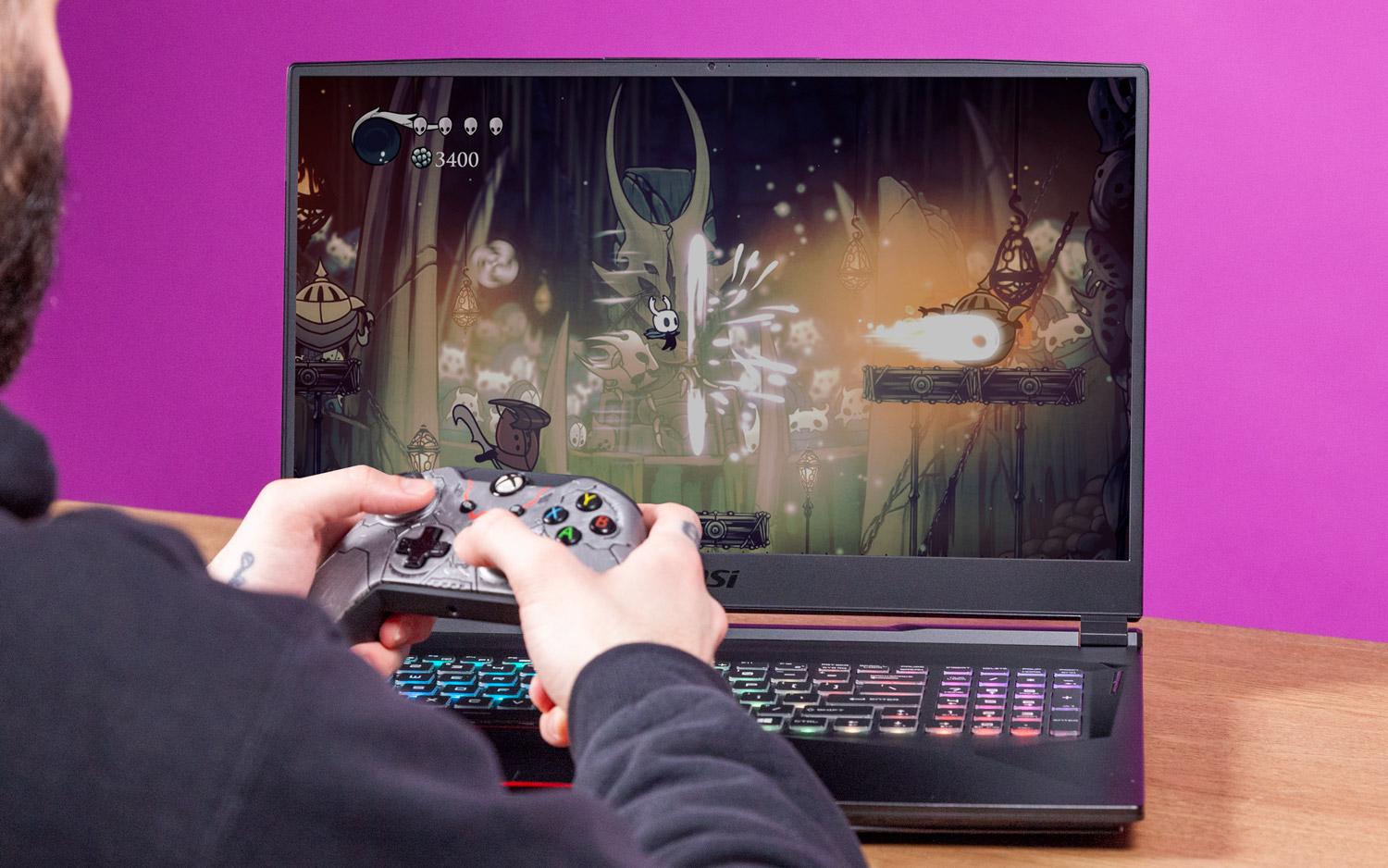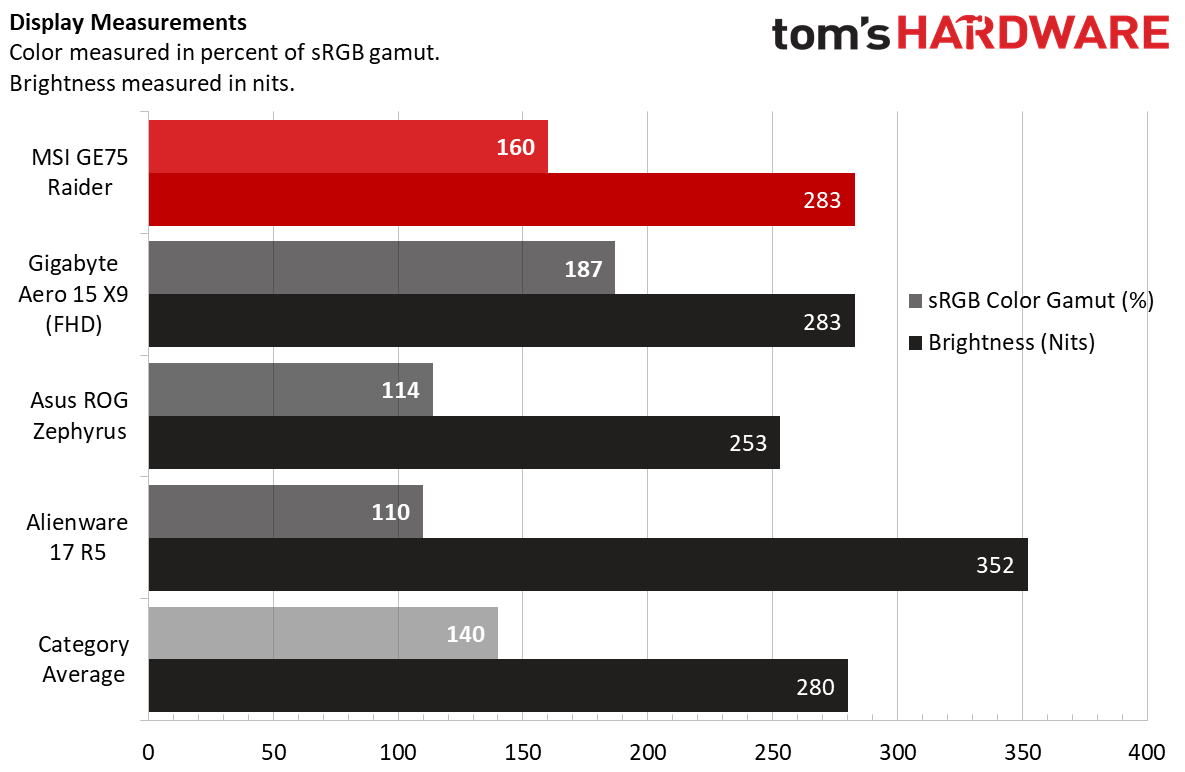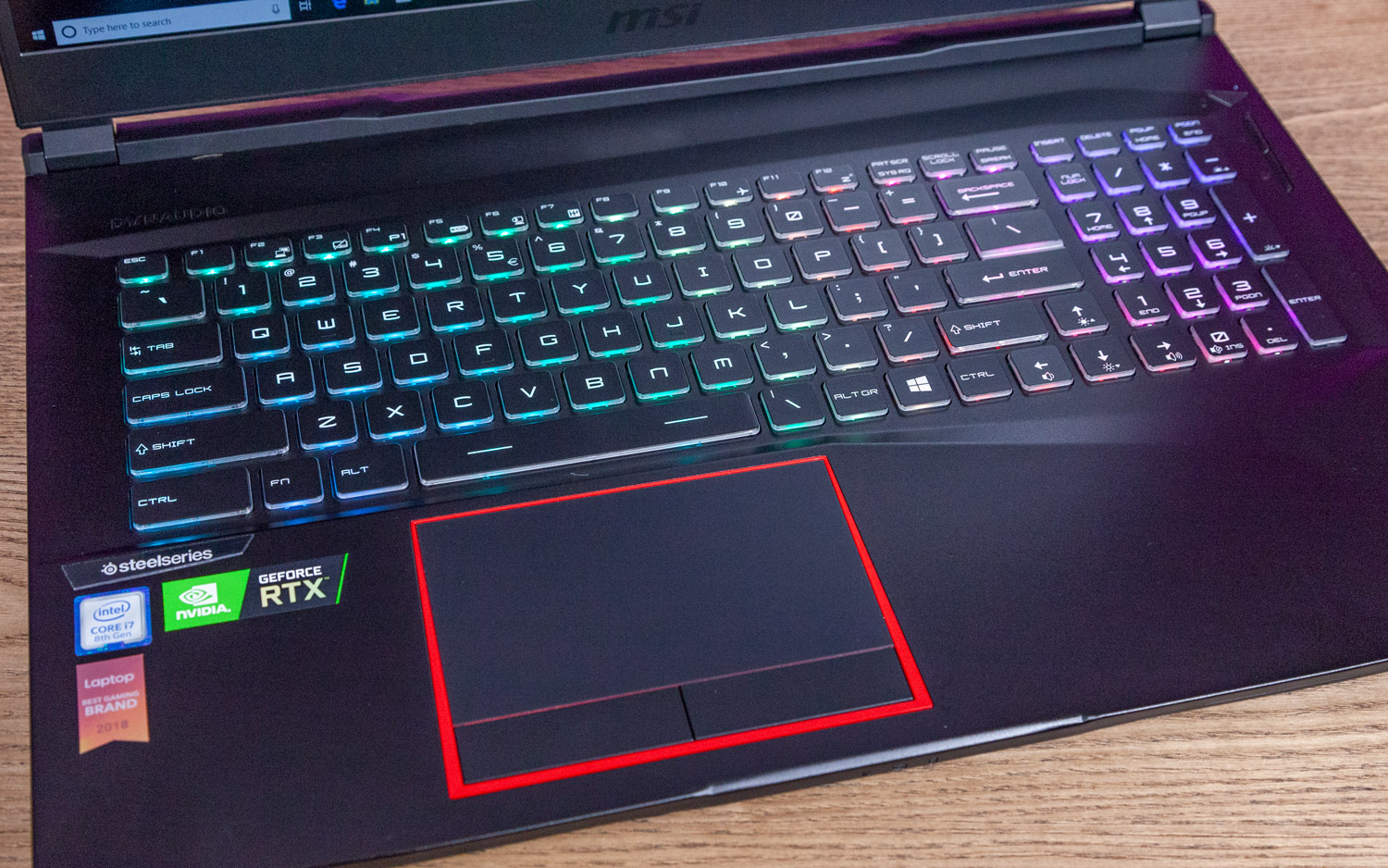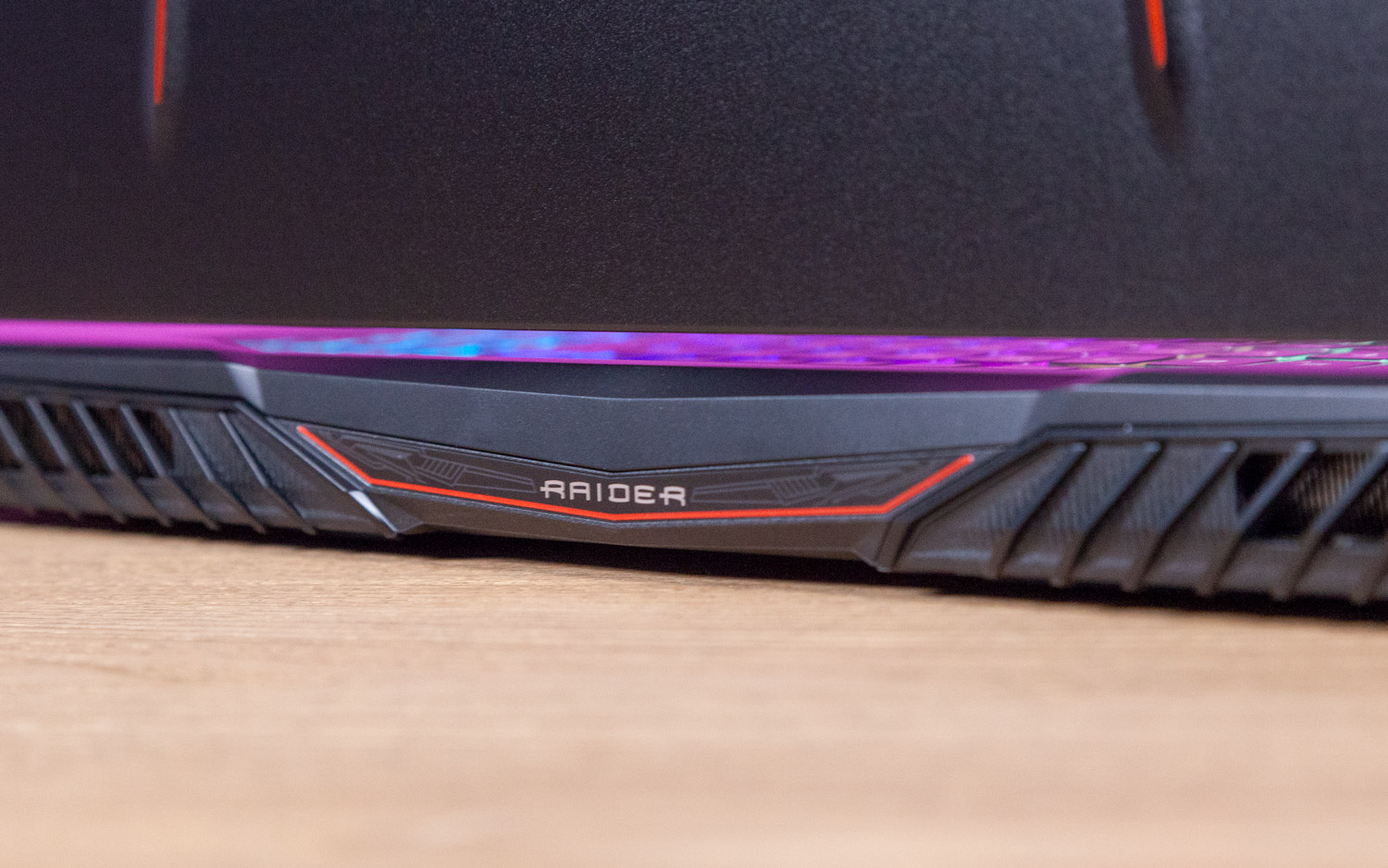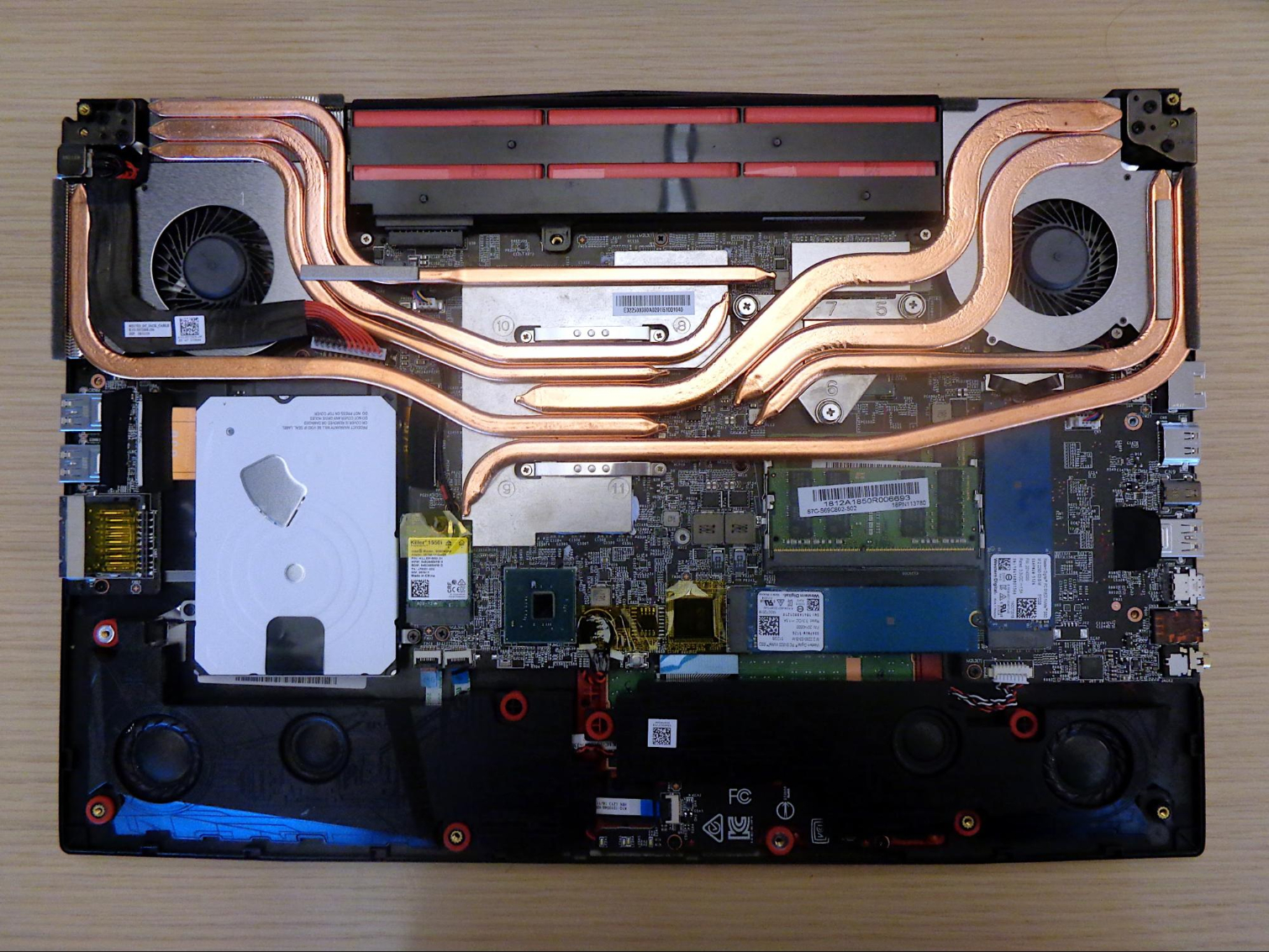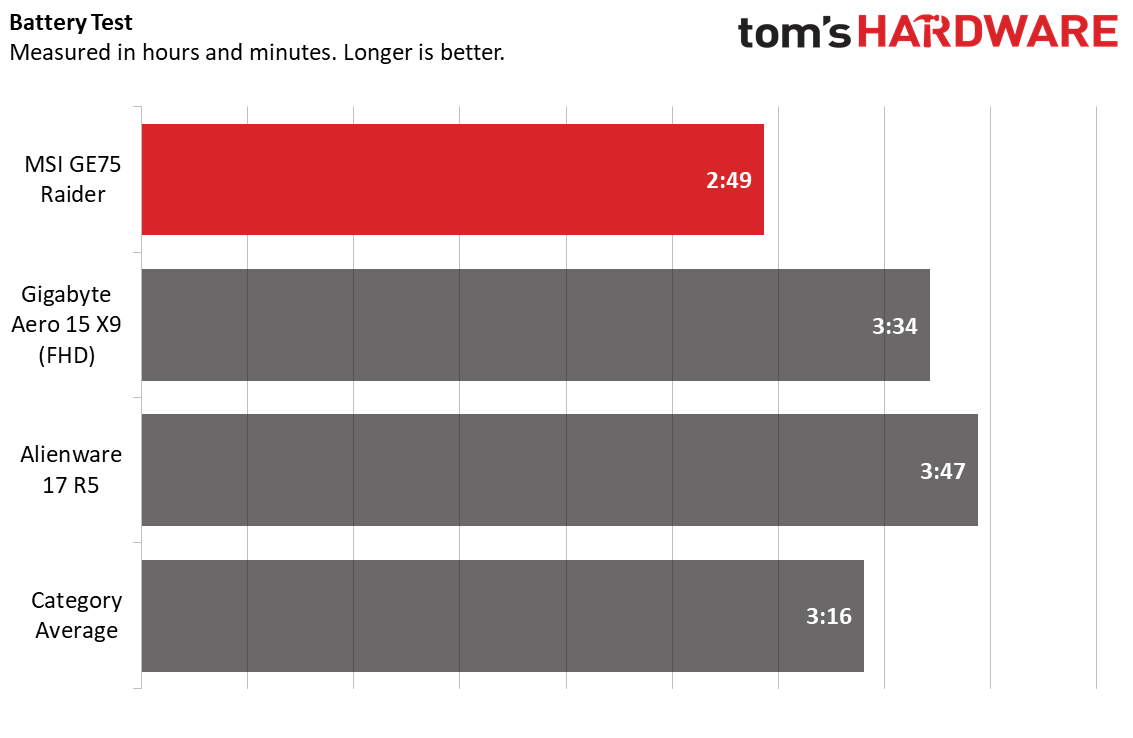Tom's Hardware Verdict
MSI combines an 8th generation Intel CPU with RTX 2080 graphics and throws in some colorful effects and a healthy amount of useful software. The result is a reliable, speedy gaming machine with style.
Pros
- +
Above-average gaming performance for this price
- +
Large, colorful display with 144Hz refresh rate
- +
Helpful gaming software
Cons
- -
Weak battery life
- -
Grainy webcam
- -
Performed below average in some productivity benchmarks
- -
Runs pretty hot when gaming
- -
High price tag
Why you can trust Tom's Hardware
Gaming laptops this year are all about seeing what you can do with Nvidia’s GeForce RTX graphics technology. MSI’s GE75 Raider ($1,999 / £2000 to start, $2,999 / £2800 as tested), promises high frame rates, ray tracing and reliable compute power with an RTX 2080 graphics card and 8th generation Intel CPU. Those components are combined with a fast and vivid display, and attractive RGB lights to make a machine with impressive performance and looks to match.
Specifications
| CPU | Intel Core i7-8750H |
| Graphics | Nvidia GeForce RTX 2080 (8 GB GDDR6) |
| Memory | 32 GB DDR4-2666 |
| SSD | 512 GB NVMe-PCIe |
| HDD | 2 TB |
| Display | 17.3 inches, 1920 x 1080, 144 HzResponse time: 3 ms |
| Networking | Killer N1550i Combo 802.11ac (2x2 ac) |
| Video Ports | HDMIMini DisplayPort 1.2SD card readerMic jackHeadphone jackRJ-45 ethernet |
| USB Ports | USB 3.1 Gen 2 Type-C2x USB 3.1 Gen 11x USB 3.1 Gen 2 |
| Audio | 2x 3 watt speakers2x 3 watt subwoofers |
| Camera | 720p webcam |
| Battery | 65 Whr |
| Power Adapter | 280 W |
| Operating System | Windows 10 |
| Other Features | Tobii eye tracking, Alienware Graphics Amplifier port |
| Dimensions (WxDxH) | 15.6 x 10.6 x 1.1 inches / 396.2 x 269.2 x 27.9mm |
| Weight | 5.9 pounds / 2.7kg |
| Price (as configured) | $2,999 / £2,800 |
Design
MSI balances sophistication and subtle style with the GE75 Raider. From top to bottom, it’s crafted with careful, understated detail.
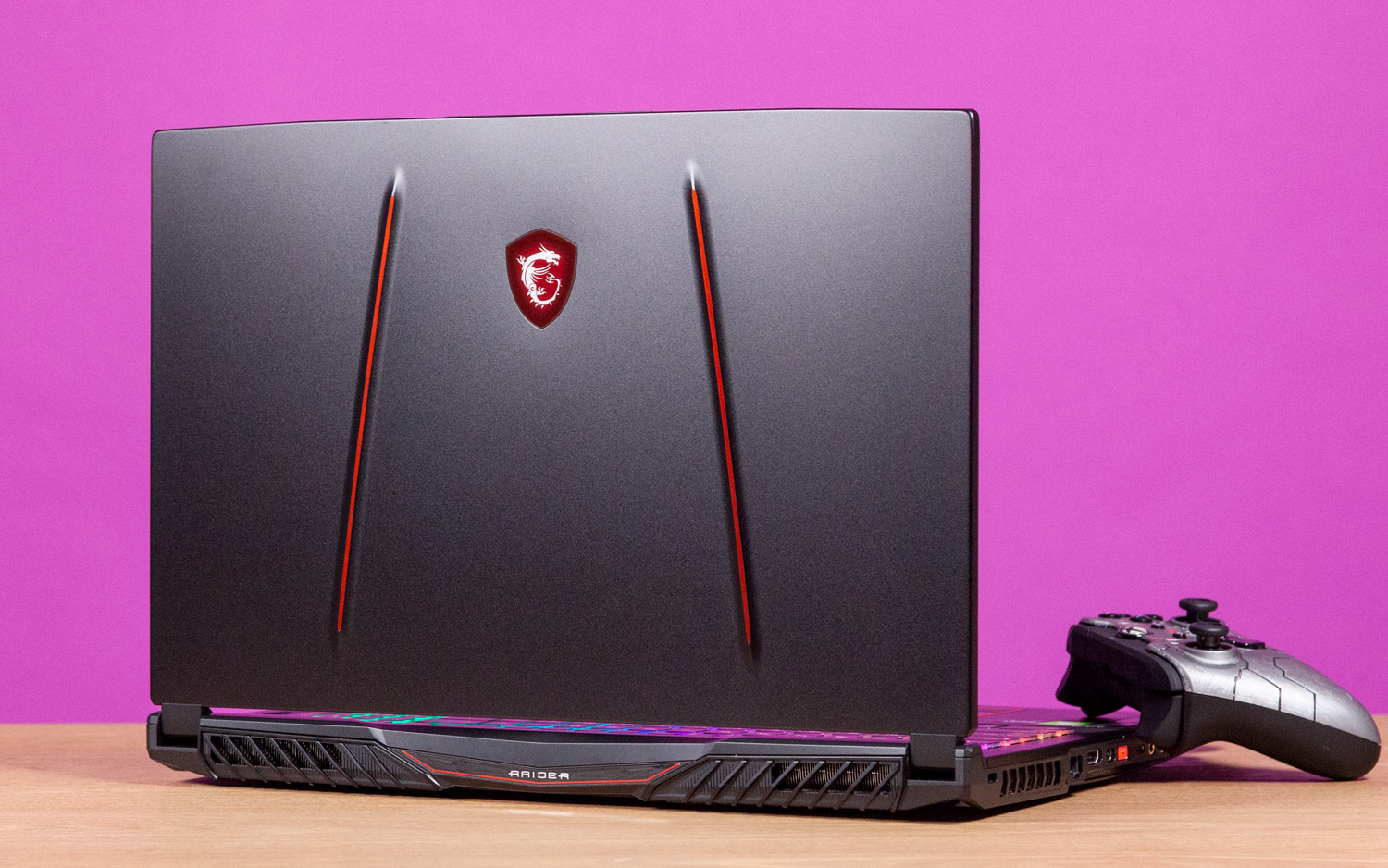
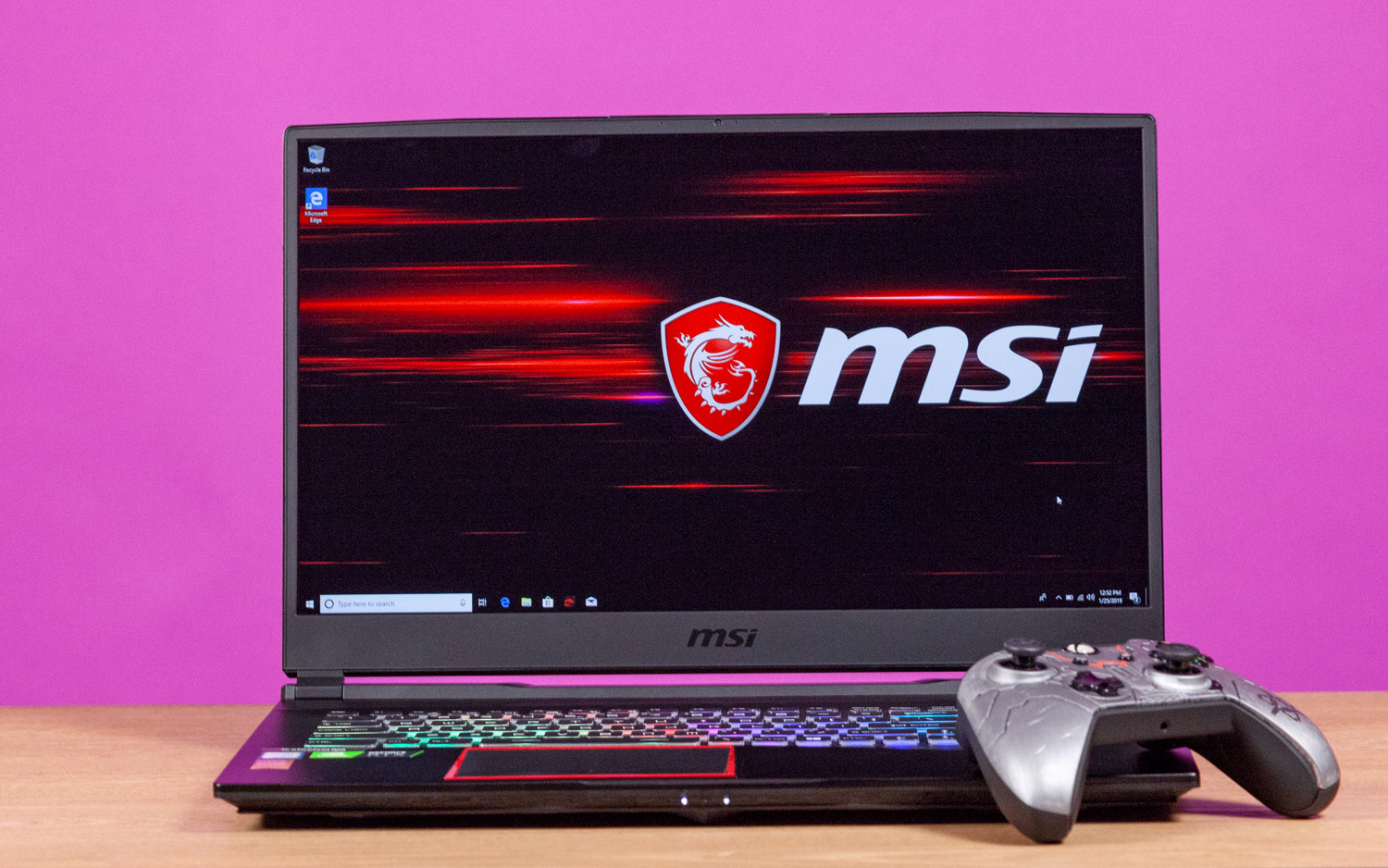
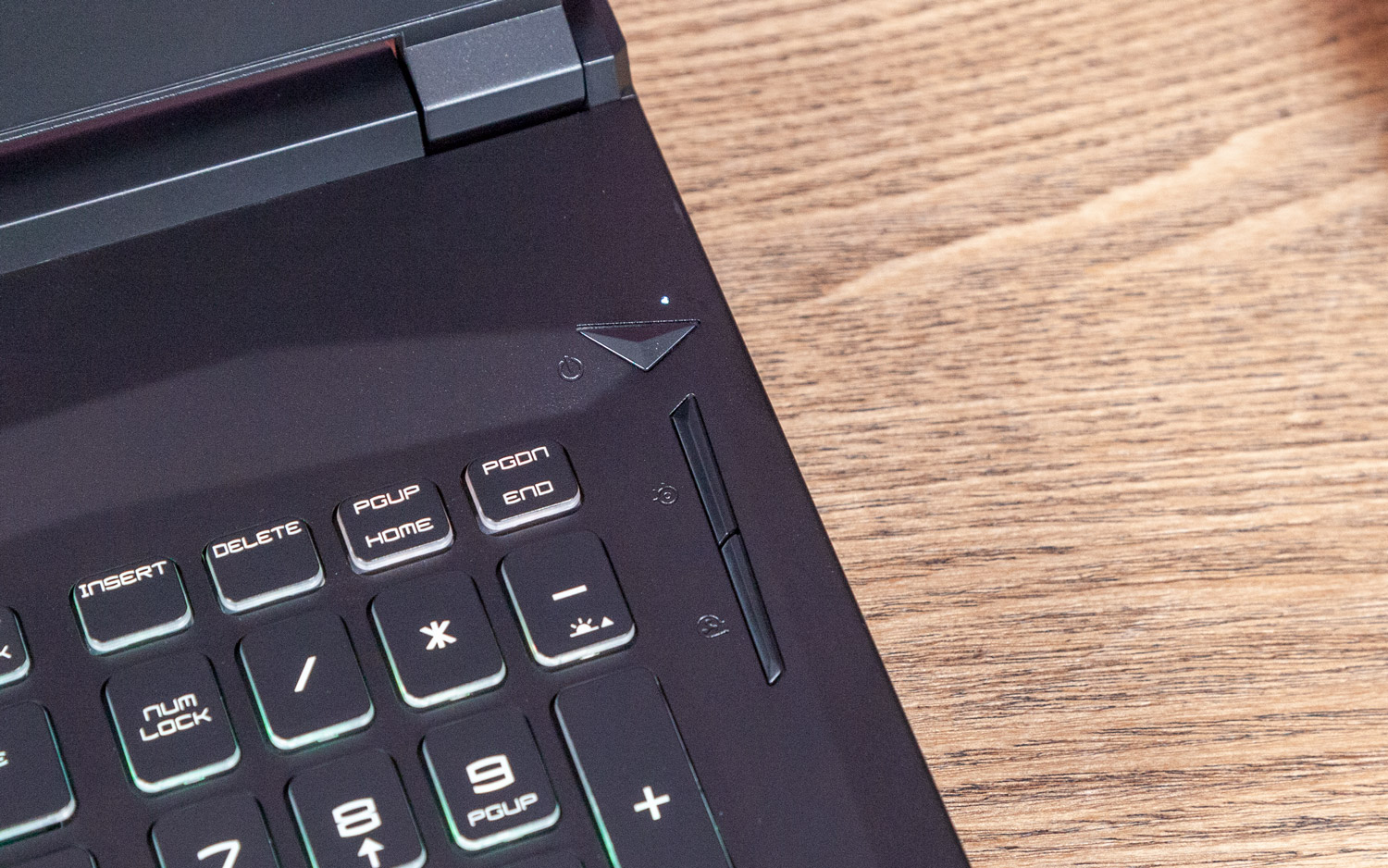
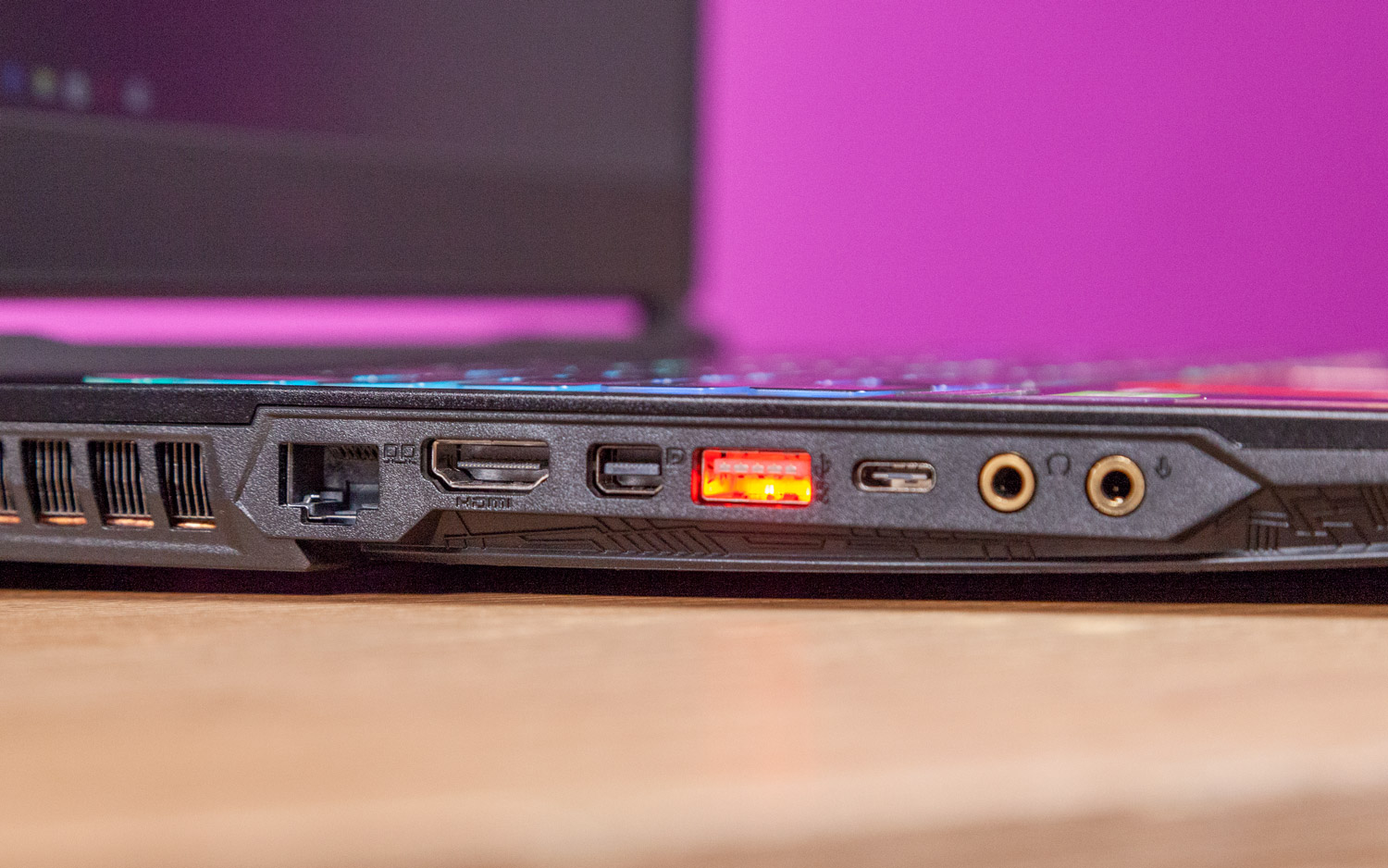
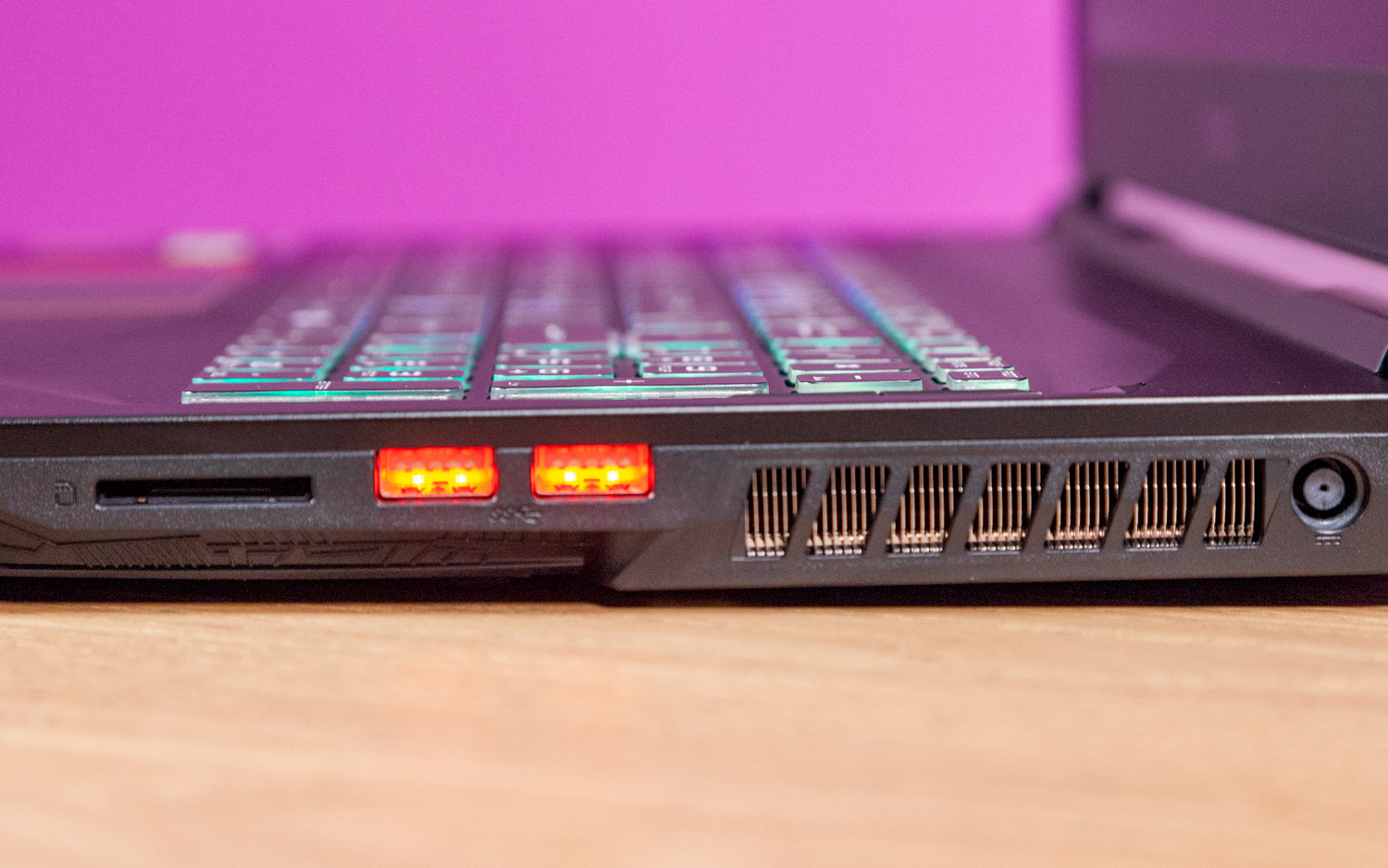
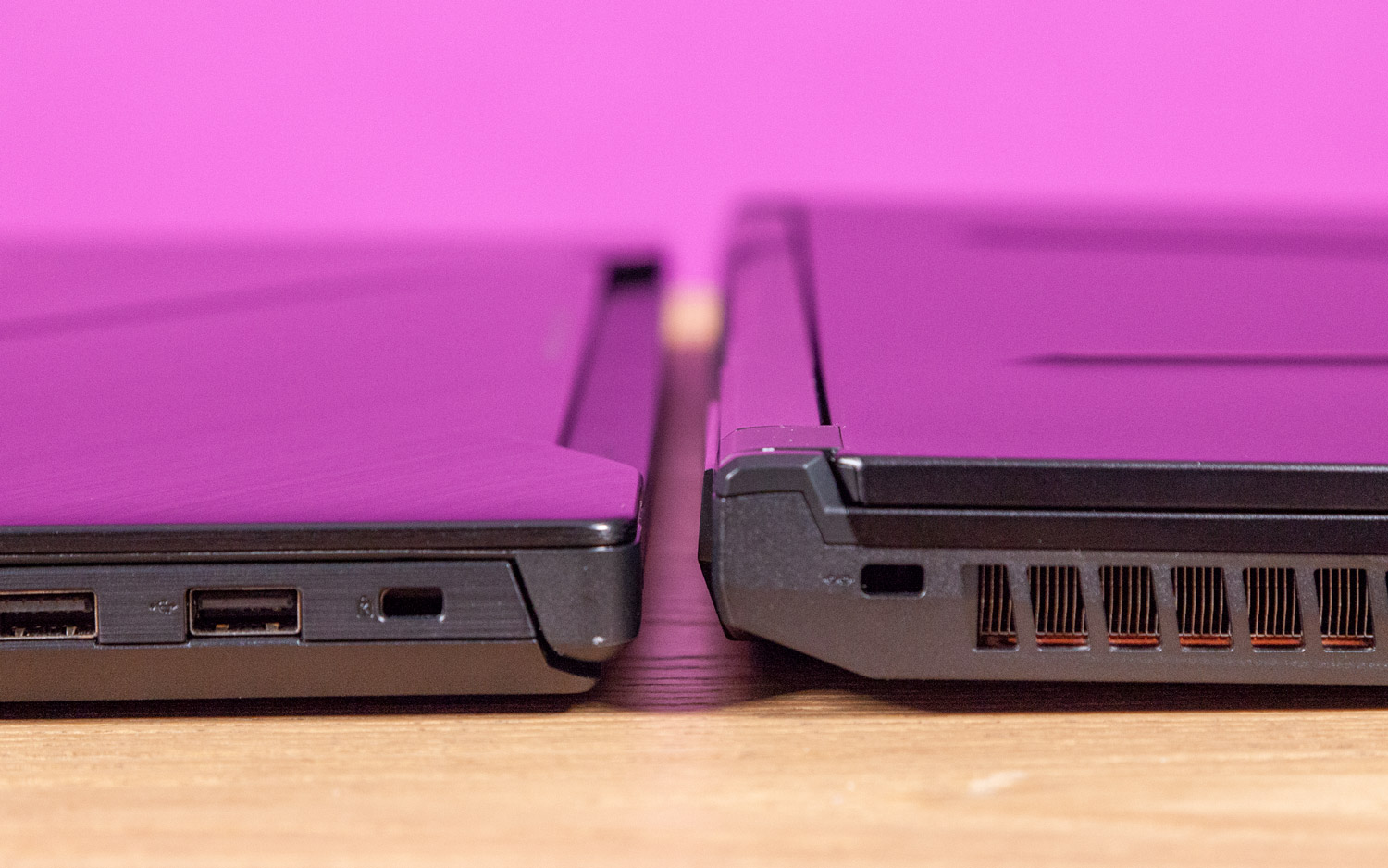
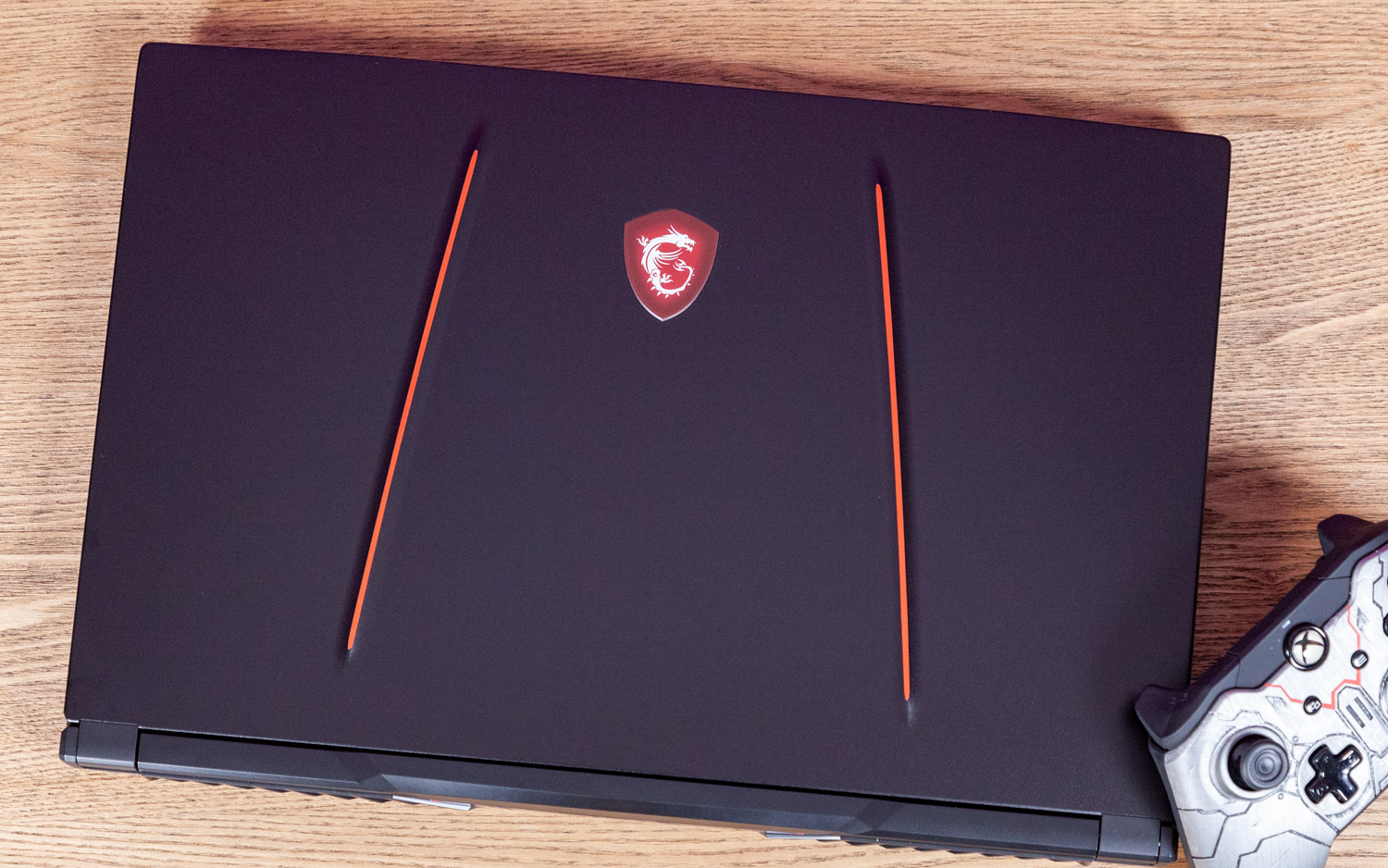
It comes in Aluminum Black with just enough red to keep things fun, yet classy. The lid attracts fingerprints, but your eyes will be drawn to MSI’s coat of arms sporting a dragon. Flanking the emblem are new additions to MSI’s gaming laptop aesthetic: two raised, red stripes. MSI calls these “3D dragon spines” (I’d argue that a dragon has just one spine). Logic aside, they’re just the right amount of flair.
Three 5.7-mm bezels and one wider bottom bezel, with a black-on-black MSI logo, surround the 17.3-inch display for an 82 percent screen-to-body ratio.
The RGB keyboard, which includes a number pad, has an all-caps font, except for the letter n, which for some reason is lower-case. The deck has a triangular power button under a teeny, tiny light that turns red when the machine’s on. Below that is an angular button for toggling through the keyboard’s pre-set RGB lighting profiles and one for maximizing fan speed.
Ports on the left side include an RJ-45 ethernet jack, one port each for HDMI, Mini DisplayPort, USB 3.1 Gen 2 and USB 3.1 Gen 2 Type-C, plus separate headphone and mic jacks and a security lock. On the right side is an SD card reader, a pair of USB 3.1 Gen 1 ports and the charger connector. All of the USB 3 ports have red LED lighting, which is controllable via the included MSI Dragon Center software. The lighting can be static, breathing or flashing with varying brightness, but is always red (or off).
The GE75 Raider measures 15.6 x 10.6 x 1.1 inches (396.2 x 269.2 x 27.9mm) and weighs a healthy 5.9 pounds (2.7kg). That’s notably heavier and than the Gigabyte Aero 15 X9 (4.7 pounds, 14 x 9.8 x 0.7 inches) and Asus ROG Zephyrus (5 pounds, 14.9 x 10.3 x 0.7 inches) but much more petite than the Alienware 17 R5 (9.8 pounds, 16.7x 13.1 x 1.2 inches).
Get Tom's Hardware's best news and in-depth reviews, straight to your inbox.
Gaming, Graphics and VR
With an Nvidia GeForce RTX 2080 graphics card with 8GB of GDDR6, the GE75 Raider beat all of our comparison laptops when it comes to frame rates.
When I played Battlefield V, first with DX12 on and ray tracing off and graphics at high, the game ran between 130 and 145 frames per second (fps) and occasionally dropped as low as 108 fps. I didn’t notice any stuttering. With ray tracing and DX12 enabled and graphics at high, the frame rate dropped to 60 to 75 fps. In exchange, the small streams of water trickling through a North African battle zone became brighter, shinier and more vibrant. However, I couldn’t immediately tell if the reflections on surrounding boulders looked better or not, (but this may be a comment more on ray tracing tech than the laptop itself).
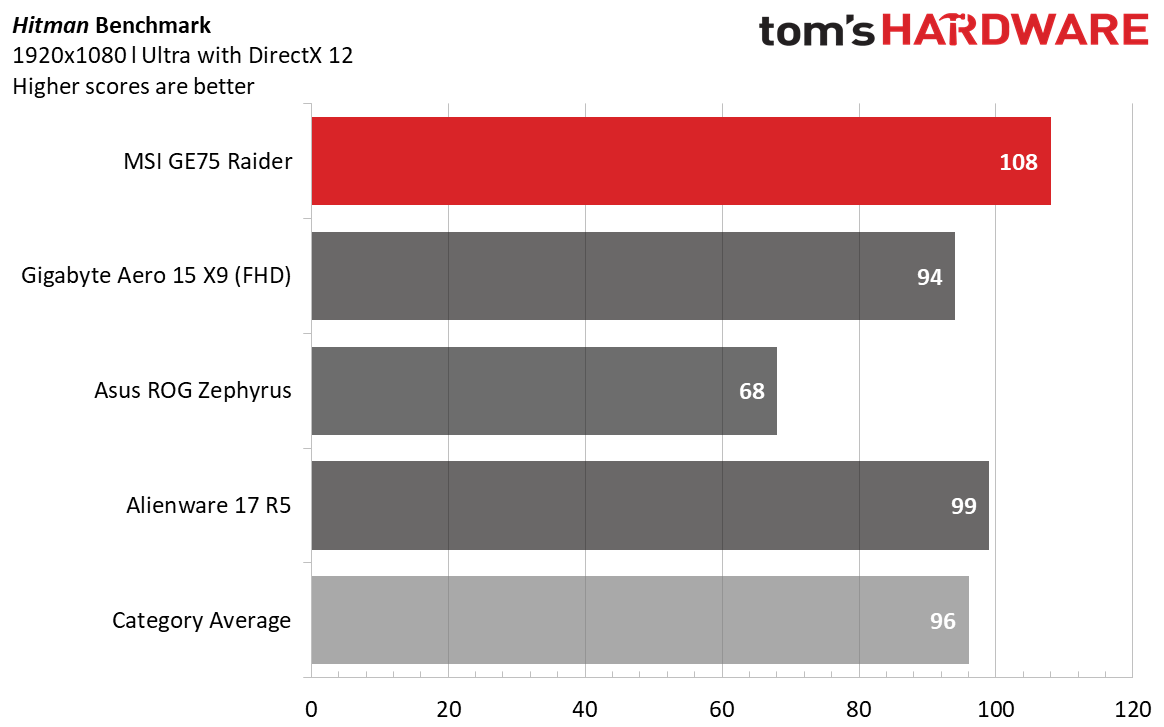
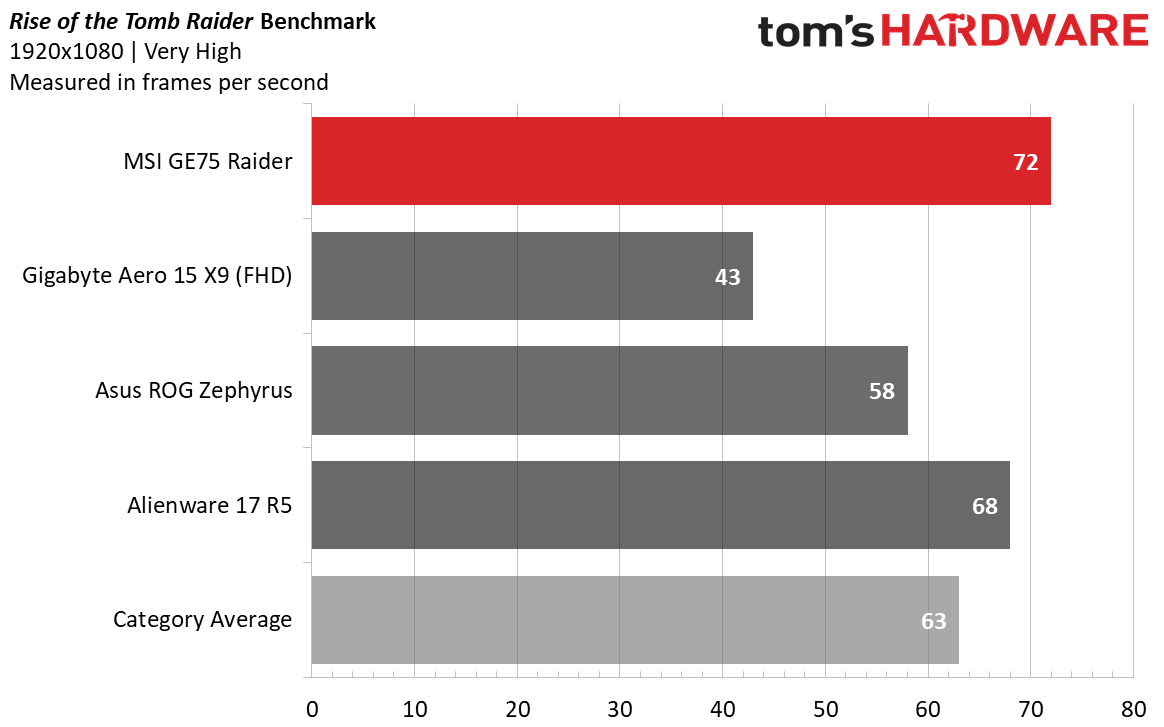
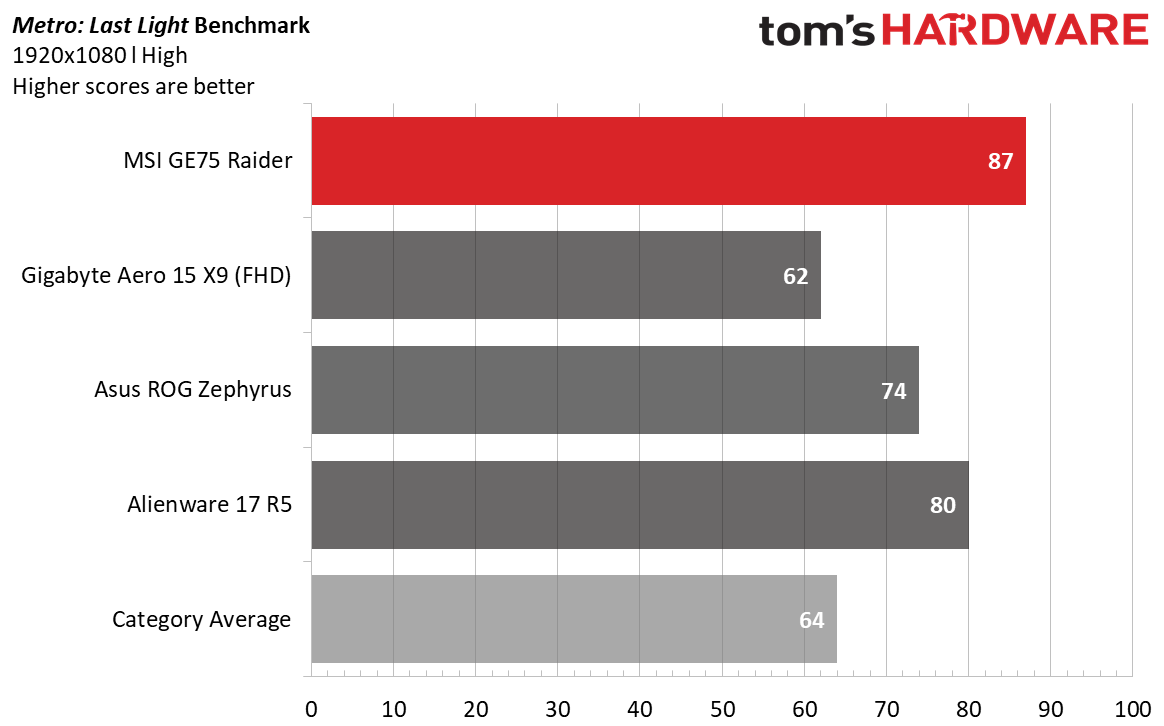
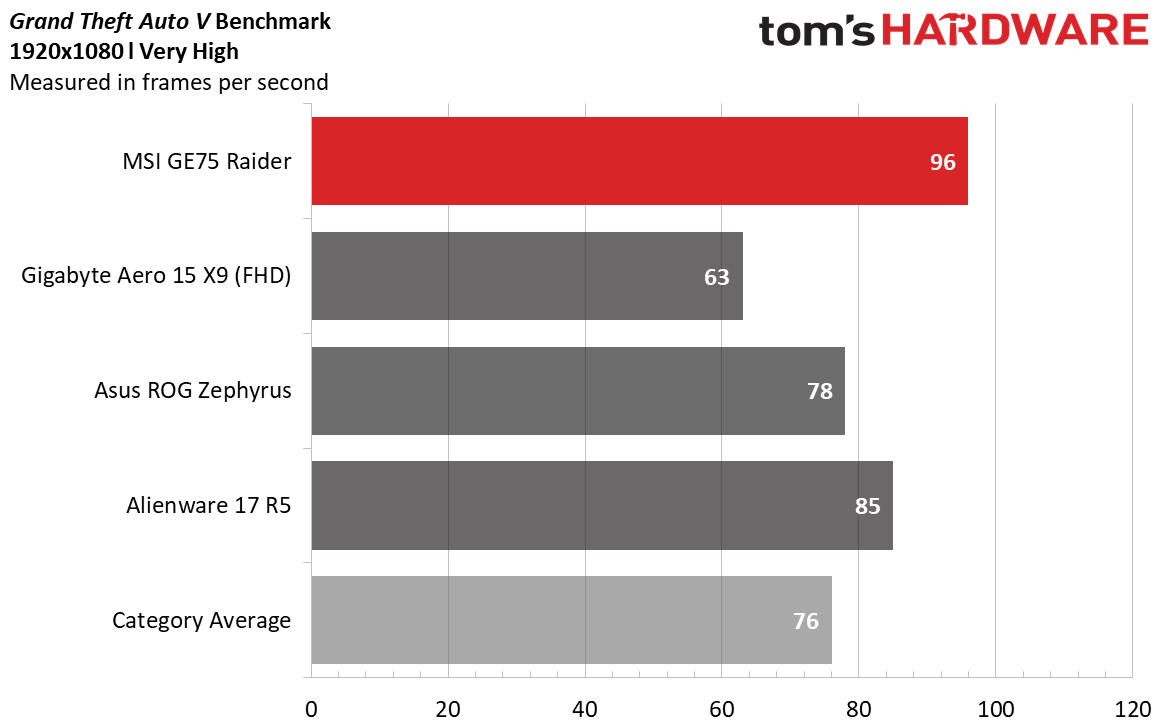
Our GE75 Raider played the Hitman benchmark (DX12 on, ultra settings) at 108 fps, outgaming the Aero 15 with its lesser RTX 2070 Max-Q graphics, as well as the ROG Zephyrus (GTX 1080 Max-Q) and Alienware (GTX 1080), as expected.
Rise of the Tomb Raider (very high) ran at 72 fps, again outperforming all of our comparison laptops and the category average.
The Raider played Metro: Last Light (high) at 87 fps, just managing to edge out the Alienware and leaving all the other comparison machines in the dust.
Grand Theft Auto V (very high) ran at 96 fps, more than 10 fps higher than each device in our comparison sample and the category average.
To stress test the machine, we ran the Metro: Last Light benchmark 10 times in a row, which simulates about 30 minutes of gaming. During that time, it ran at an average of 89 fps, occasionally reaching 90 fps. The CPU ran at an average clock speed of 3.1 GHz and an average temperature of 86 degrees Celsius (186.8 degrees Fahrenheit). The GPU’s temperature was 76.4 degrees Celsius (169.5 degrees Fahrenheit).
It earned a score of 11 on the SteamVR test, meaning you should be able to enjoy VR gaming on your HTC Vive or Oculus Rift with this machine.
Productivity Performance
With a 6-core, 12-thread Intel Core i7-8750H CPU, 32 GB of RAM, a 512 GB NVMe-PCIe SSD and 2 TB HDD, our configuration of the Raider GE75 offered reliable productivity performance for my workloads and should be able to sustain much more. However, competitors often bested it in our benchmarks.
When I opened 21 tabs on the GE75 Raider, including one streaming The Office, there was no lag. I was able to switch through tabs rapidly without stuttering, and Michael and Dwight’s pestering of a Canadian hotel clerk carried on uninterrupted.
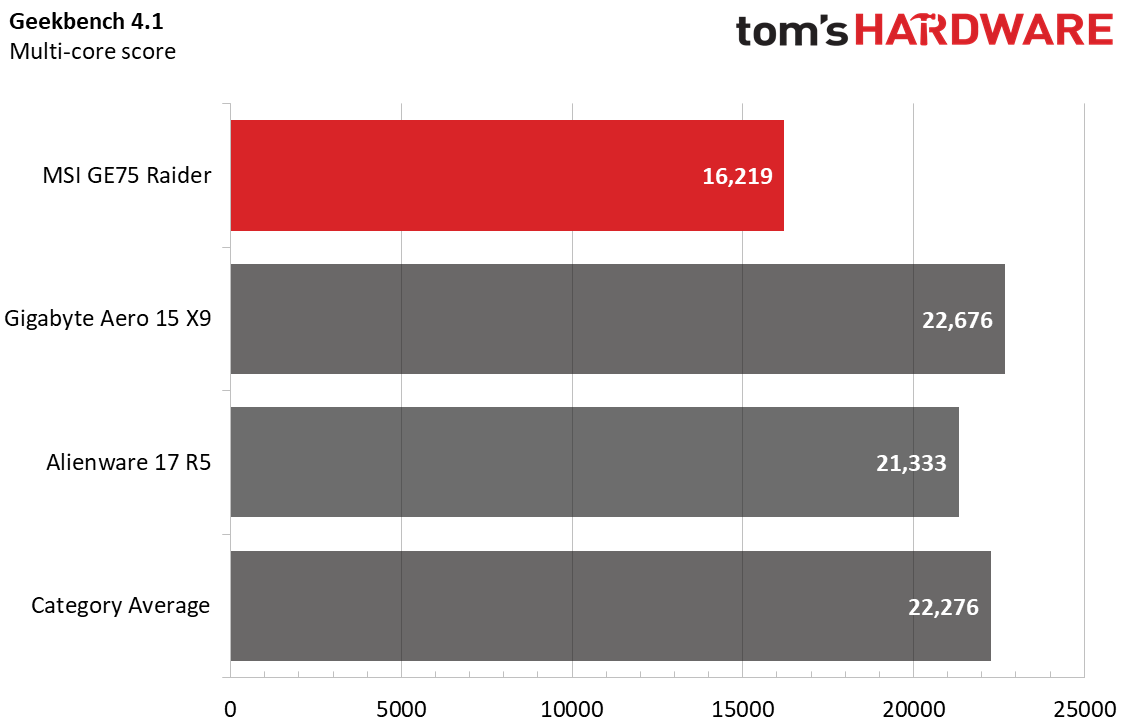

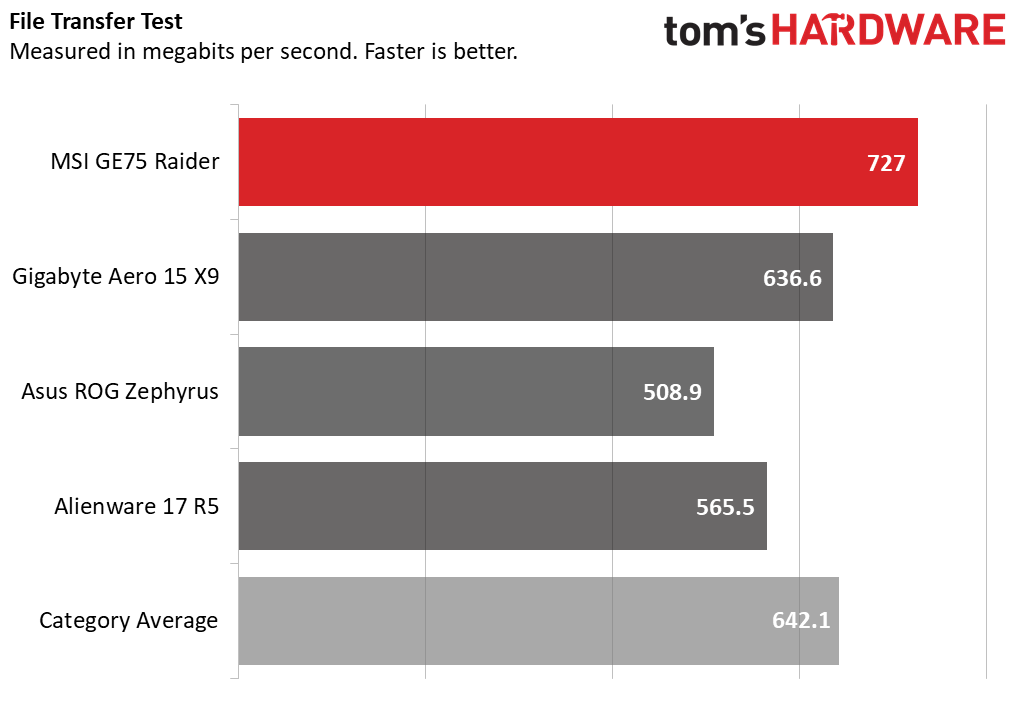
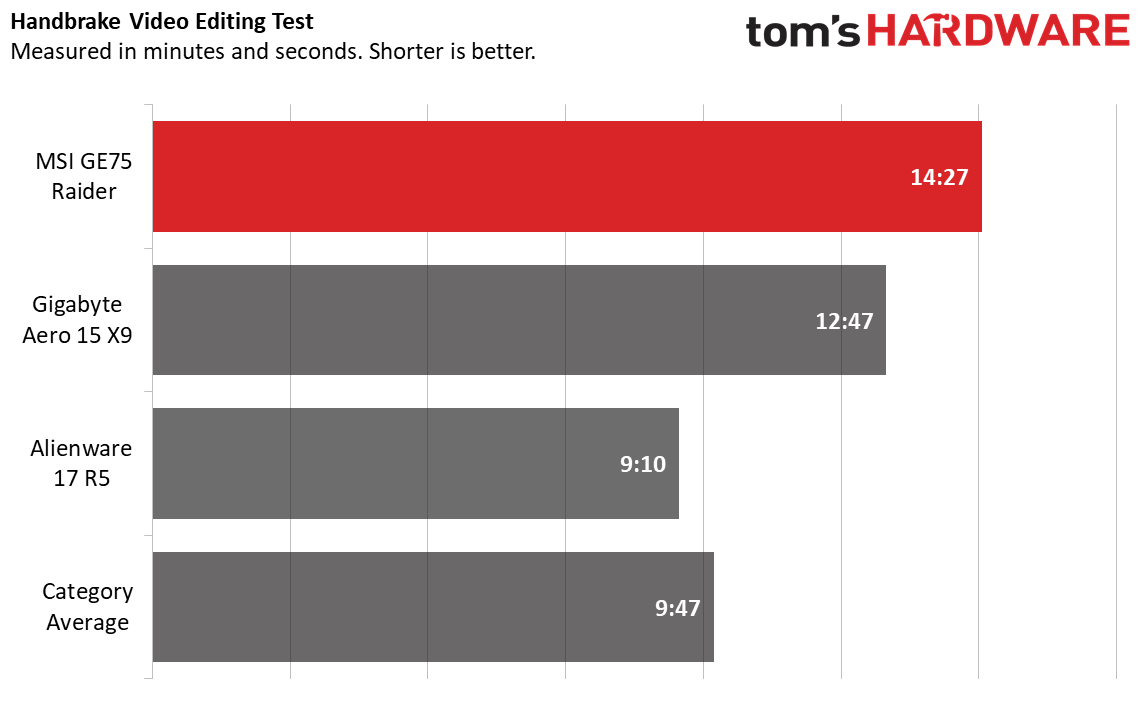
In Geekbench 4.1, an overall performance benchmark, the GE75 Raider earned a score of 16,219. This is bit disappointing in comparison to the Aero 15 and Alienware (we don’t have figures for the ROG Zephyrus). While both of those laptops have more powerful i9-8950HK processors (and the same amount of RAM), the GE75 Raider also fell behind the category average.
It took the Raider just 7 seconds to copy 4.97GB of files, a rate of 727 MBps. That’s quicker than all of our comparison machines and the typical premium gaming laptop.
When we tasked the GE75 Raider with transcoding a 4K video into 1080p, the machine did so in 14 minutes 27 seconds, a lengthy amount of time for this category, especially when compared to the Alienware.
Display
The GE75 Raider’s 17.3-inch, FHD resolution panel makes for a great display. It sports a 144 Hz refresh rate and 3 ms response time. You may see marketing claiming its an “IPS-level display.” However MSI confirmed to Tom’s Hardware that the panel is an SI TFT-LCD, meaning it’s a thin film transistor liquid crystal display with an amorphous silicon backplane, for faster refresh rates and better viewing angles and energy efficiency.
When I watched Tears of Steel, an open source, 4K movie, the image was diamond-sharp. Bright pinks and purples and the hazel of an actress’ eyes were powerful. And red AR layered upon someone’s flesh was bold and distinct. Even dying, fading-green shrubs with dead, copperish leaves amongst a rust gold scene were apparent. And in a Battlefield V, I could spot the subtle differences between gray, gray-blue and gray-brown and see sunspots by the horizon.
And in true “IPS-level” style, the viewing angles were great with hardly any glare at all when viewing from the side. You can even view it from a perpendicular angle if you don’t mind a drop in brightness.
Our testing showed the display covers 160 percent of the sRGB color gamut, which is better than average. However, the Aero 15’s 4K display is more colorful.
In terms of brightness, count on the GE75 Raider reaching up to 283 nits. This matches the Aero 15 and is even better than the Zephyrus, but it’s no match for the Alienware’s luminosity.
Our review unit also came with MSI True Color software. This program lets you toggle between six modes, sRGB (default), Gamer, Anti-Blue (for reducing eye fatigue), Designer, Office and Movie. Each has individual sliders for controlling things like brightness, color temperature, color gamut, contrast and more, depending on the mode. The software also has tools for App Sync, Desktop Partition, Calibrate (for calibrating with a colorimeter), a Help section and more.
Keyboard and Touchpad
The GE75 Raider’s keyboard is a snappy, colorful (if desired) delight. It has a generous 1.9mm of travel, requires 70g of force and makes light, but noticeable, clicking noises with each press. On the 10FastFingers.com typing test, I typed 118 words per minute—very high for me—with just a one percent error rate.
RGB addicts will love this keyboard, which has per-key lighting for its 16.8 million color backlight. This is controllable via the included Steelseries Engine 3 software, which also has 8 different presets, My favorite is Disco, which makes each key go through its own rainbow cycle in a twinkling, groovy fashion. You can also toggle through the RGB profiles through a button on the laptop’s deck.
The only thing that threw me off at first is the length of the tilda key that's next to the 1 key. It’s longer than the numbers on its row, so I accidentally hit it many times when trying to type "1." But it’s certainly something you can get used to.
The 4.2 x 2.4-inch touchpad on the GE75 Raider is smooth and matte with large buttons that make a strong click. Windows gestures, like three- and four-finger taps, worked on the first try.
Audio
The GE75 Raider has two 3W Dynaudio “Giant Speakers” and two 3-watt woofers on its bottom.
As I trotted around North Africa in Battlefield V, I heard the varying sounds of William Sidney Bridget’s footsteps as he trudged through water, rocks and dirt. I could tell planes flying overhead were at differing distances and noticed the distinct vibrating noises produced by a dangerous Stuka.
When I played “You” by Atmosphere, the sound was powerful enough to fill a medium-sized conference room. When I opened up the Nahimic software and turned on Surround Sound and the Volume Stabilizer, I got the booming volume I craved. There are also controllers for voices, treble and bass; although I could’ve used a touch more bass. Placing the laptop on my lap barely hurt volume or sound quality at all.
Upgradeability
Upgrading the GE75 Raider requires a lot of elbow grease. The bottom has 13 Phillips head screws, including one under a factory seal sticker. That sticker may make you think that breaking it voids your warranty, but that’s illegal in the U.S. Plus, we spoke with MSI, and they confirmed that the sticker is just so MSI knows if the case was open should they get a return and/or RMA and that breaking the sticker doesn't break the warranty.
Prying off the bottom was no easy task and required a spudger. After succeeding, the first thing I noticed was that MSI carried the "cosmological warship" design over to the speakers, despite this being completely invisible during use. Upgrade-wise, the HDD and WIFi module are secured with one Philips screw each.
Difficulties come with trying to swap the RAM (the GE75 Raider supports up to 32GB) or SSD. One of the RAM sticks pops right out of the SODIMM slot, but the one underneath it is hard to remove because it’s under a heat pipe. The vertical SSD, secured with one screw, had the same problem. Unscrewing it was hard since my screwdriver kept crashing into the heat pipe, and I never managed to wrangle it out from under the heat pipe, although it may be possible. The other SSD, further from the heat pipe, took a lot of wiggling to free because because both SSDs sit on top of two very sticky thermal pads.
Battery Life
You won’t be going far with the GE75 Raider without a charger, as it has a dismal battery life, which is typical for a gaming laptop. On our battery test, which continuously browses the web over Wifi at 150 nits of brightness, the machine lasted just 2 hours and 49 minutes. The average gaming laptop in this price tier lasts 27 minutes longer, while the Alienware impressively lasts almost an hour longer.
Heat
The GE75 Raider employs MSI’s Cooler Boost 5+ module, which uses eight pipes, four exhausts and 31 fan blades to try to keep the 2080 at a safe temperature.
After streaming 15 minutes of HD video from YouTube, it was 37.5 degrees Celsius (99.5 degrees Fahrenheit) between the G and H keys, 29.2 degrees Celsius (84.5 degrees Fahrenheit) at the touchpad and its underside was 34.2 degrees Celsius (93.5 degrees Fahrenheit).
After playing Battlefield V for about 15 minutes with the turbo fan on, things got more heated.
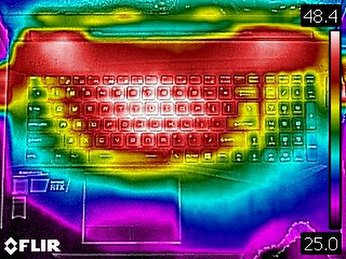
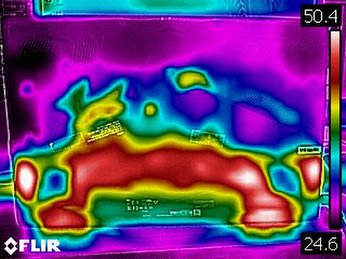
The spot between the G and H keys was 48.4 degrees Celsius (119.1 degrees Fahrenheit), but the touchpad was much cooler, with its hottest point around 37 degrees Celsius (98.6 degrees Fahrenheit). Underneath above the battery, the hottest point, was a torrid 50.4 degrees Celsius (122.7 degrees Fahrenheit).
Webcam
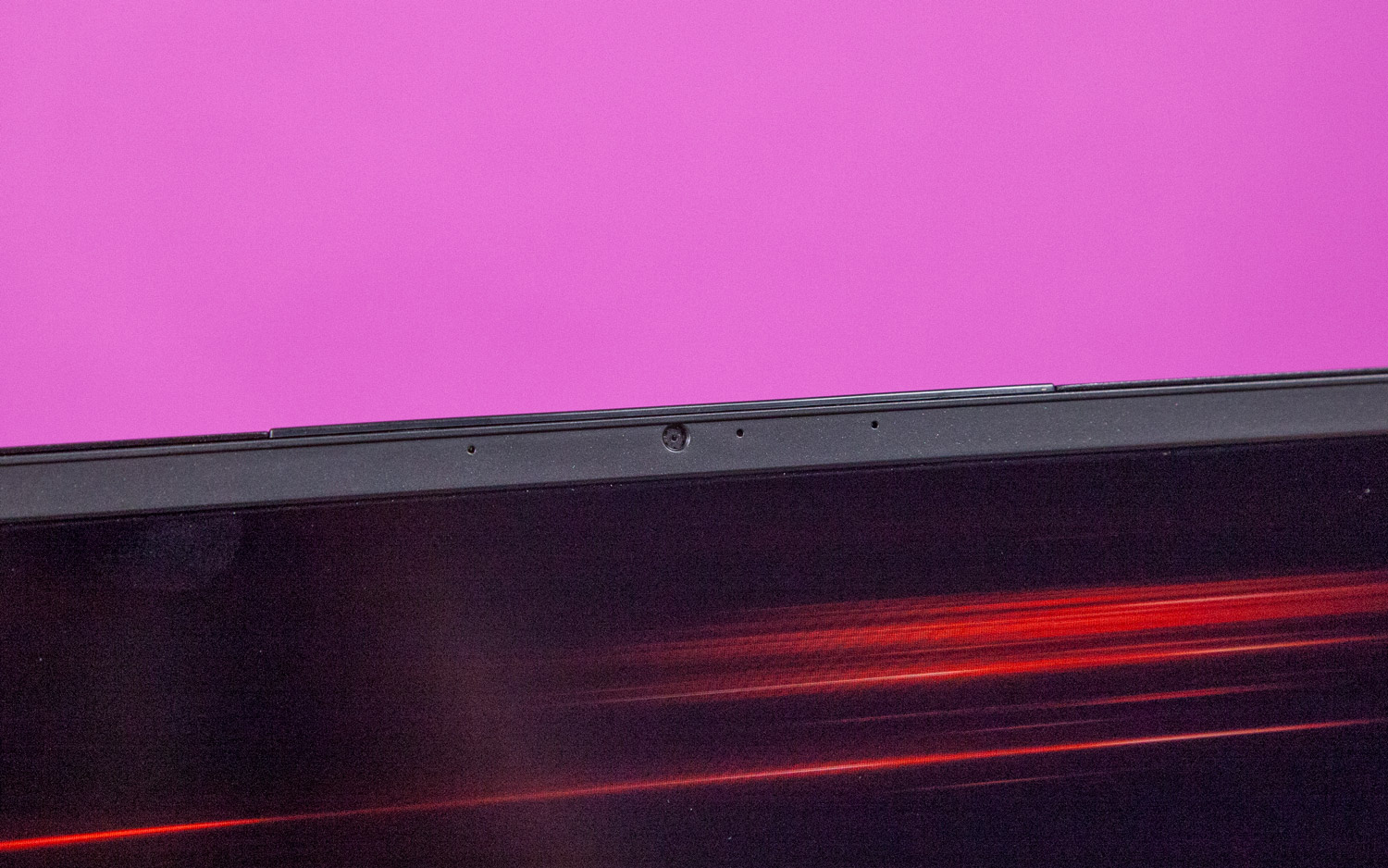

Images produced with the GE75 Raider’s 720p webcam are as grainy as sand. When I took a picture in our office, every part of me, from my hair, to my skin, to my clothes, had plenty of visual noise. The background was almost completely washed out, with the windows not visible at all. Our white popcorn ceiling lost all detail and mysteriously had a faded, yellowish brown area, despite it being white in real life. My skin, hair and clothes were color-accurate though. However, my skin had a watercolor effect to it, which, while flattering, is not true to life.
Software and Warranty
Our review unit came with MSI App Player for playing mobile games on the PC. It also lets you access BlueStacks App Player for running mobile games faster and at full screen.
There’s also Dragon Center 2.0, which shows you CPU, GPU, memory and disk usage and prioritize game apps, lets you fine-tune things like the USB lighting, DPI and more and switch audio and display profiles. You can also enable and adjust Gaming Mode profiles for different games and visit voice, mobile and tools and help options.
Killer Control Center, looks at your app usage and prioritizes network traffic for speed-critical apps (like games). This can also help prevent lagging while streaming.
There’s also Nahimic for tweaking audio, including the microphone, and SteelSeries Engine 3 for keyboard settings. MSI also added PhotoDirector 8 and PowerDirector, which aren’t as useful.
As far as bloatware is concerned, the gaming laptop also came with Candy Crush Saga, Candy Crush Friends Saga, Cooking Fever, as well as Fitbit Coach, Music Maker Jam and others that are built into every copy of Windows 10.
MSI sells the laptop with a one-year limited warranty.
Configurations
Our configuration is the most extreme (GE75 Raider-023), with an i7-8750H CPU, RTX 2080 graphics card, 32GB of RAM, a 1TB HDD and 1TB NVMe PCIe SSD, and goes for $2,999 (£2800).
The cheapest configuration (GE75 Raider-050) costs $1,999 (£2000). That gets you the same CPU and amount of HDD storage, but a lesser RTX 2060 graphics card, half the memory at 16GB and a smaller, 256GB SSD.
In the U.S., there are various configurations in between, including the GE75 Raider-049 ($2,299) and GE75 Raider-048 ($2,799).
Bottom Line
The MSI GE75 Raider is a powerhouse gaming rig. Its high-end specs deliver gaming performance that surpasses others in this price category. It also comes with some handy software and has a brilliant display built for high-speed gaming.
It comes at a hefty price though, and it scored below average for gaming laptops in this price range in three out of four productivity performance benchmarks. If you can’t afford to sacrifice any productivity performance, you may be better off with the Gigabyte Aero 15 X9; however, it was always behind the GE75 Raider in our gaming tests.
But if you’re looking for high-end gaming performance and can pay a premium price for it, the GE75 Raider is a great choice.
MORE: Best Gaming Laptops
MORE: Gaming Laptop Reviews
MORE: All Laptop Content
Photo Credit: Tom's Hardware

Scharon Harding has over a decade of experience reporting on technology with a special affinity for gaming peripherals (especially monitors), laptops, and virtual reality. Previously, she covered business technology, including hardware, software, cyber security, cloud, and other IT happenings, at Channelnomics, with bylines at CRN UK.
